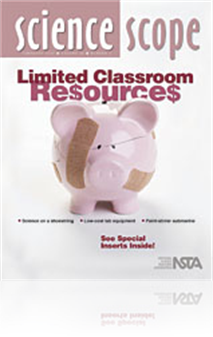All Science Scope resources
Journal Article
Science Sampler: A “handy” way to teach classification
When teaching the five kingdoms to middle school students, use this “handy” mnemonic device that helps students recall kingdom names, as well as a fact or two about each one. Simple and obvious analogies are used to captivate and retain students�...
Journal Article
Scope on Safety: Dissection—Don’t cut out safety
In June 2005, the NSTA Board of Directors adopted a revised position statement, Responsible Use of Live Animals and Dissection in the Science Classroom. Under the “Dissection” section, NSTA calls for more research to determine the effectiveness o...
Journal Article
Science Sampler: Recycling aluminum cans in the lab—Two inexpensive inquiry activities
Don’t throw away that aluminum can! Don’t even place it in the recycling bin. Instead, use it in your next science lab. In addition to the economic advantages of using materials such as aluminum cans, there are also pedagogical advantages: Physic...
Journal Article
Using Web-Based Simulations to Promote Inquiry
Science teachers seek engaging, effective, and inquiry-based activities that are standards-aligned and convenient to implement in their classrooms. For many years, the web has provided teachers and students with a vast resource of factual information...
Journal Article
Science Sampler: Making the most of limited lab facilities
Despite less-than-adequate lab facilities, it is possible to come up with creative ways to provide your students with quality, lab-based activities. These strategies include the use of basket labs, progressive hand-rinsing stations, microscaling, mod...
Journal Article
Science Sampler: The SI system on the basketball court
For many students, the metric system of SI units is so complex that it is shifted into the realm of the mystical and then forgotten. Here is a fun and easy inquiry-based activity to familiarize your students with the SI system using your school’s b...
Journal Article
Editor’s Roundtable: Never cut corners on safety
Teaching science in a less-than-adequately equipped room is unsafe and just plain dangerous. Where safety is concerned, there are no shortcuts, no make-do techniques that Science Scope authors or anyone else can offer you. School districts must pro...
Journal Article
Science Sampler: Interactive interdependence
Modifying and building on a lesson created by the Vancouver Aquarium Marine Science Centre, the British Columbia Ministry of Education, and the Provincial Learning Network (2000) that supports National Science Education Standards Teaching Standard A...
Journal Article
Books, Biodiversity, and Beyond!
Reading in science class doesn’t have to be boring, but it’s no secret to students or teachers that textbooks aren’t much fun to read. To enhance and integrate your science curriculum, try using alternative reading resources such as Biodiversi...
Journal Article
Scope on the Skies: And then there were eight
This past summer the International Astronomical Union (IAU) approved new definitions for objects in our solar system that orbit the Sun. The definitions now allow for only eight planets, while objects smaller than planets will be known as dwarf plane...
Journal Article
Science Sampler: Word wall connections
A word wall has many uses in the middle school science classroom. It is ideal for reinforcing vocabulary and connections between concepts. In this article, the author describes an interactive way to use the word wall to create food webs. In addition,...
Journal Article
Coaching to Build Support for Inquiry-Based Teaching
Coaching, as a means to support inquiry-based teaching, starts by changing the culture from within (school, teacher, and student) rather than from external mandates. Recognizing that teacher empowerment is the first step toward increasing student ach...



